Studies by Embrapa and partners resulted in the first quality and traceability protocol for Brazilian pine nuts. Those characteristics contribute to the obtention of a Geographical Indication (GI) seal. Combining traceability with the GI seal lends more quality and adds value to the product in the market. Two cooperative unions are set to adopt the recommended criteria in the 2025 harvest. Standards for Brazilian pine nuts in the Paraná consumer market will inspire similar initiativas in other producing states: Santa Catarina, Rio Grande do Sul, São Paulo and Minas Gerais. Studies conducted by Embrapa Forestry and partners resulted in the first quality and traceability protocol for Brazilian pine nuts – the edible and nutritious seeds of the Paraná pine, Brazilian pine or araucaria (Araucaria angustifolia). The solution paves the way for the creation of the Geographical Indication (GI) seal for the species in Brazil, which would provide consumers with quality assurances. The differentials provided by agricultural research would add increasingly more value to the regional food, which has grown in importance in the domestic market, with potential for growth in the international market. The new protocol covers the stages from collection to consumption and represents a milestone in the production chain towards higher appreciation of this Brazilian food product that is sourced from forests and is typical of the country's South and Southeast. In the same line of action to strengthen araucaria as a potentially profitable species to be kept standing from originary forests or planted, generating a sustainable non-timber product, there is a preliminary study on Brazilian pine nut Geographical Indication (GI) seals based on local characteristics and sensory attributes. Photo: Luiz Costa The protocol is the first step to have Brazilian pine nuts be classified and traceable in the market. Two cooperatives in Paraná already plan to adopt the recommendations starting from 2025, by improving gathering, separation, storage and sale of fresh seeds. “It will not be a requirement, but as farmers, technicians and consumers see the positive results of the recommended practices, the adoption of the protocol will tend to occur spontaneously”, explains Rossana Godoy, a researcher at Embrapa Forestry and one of the authors of the document. As it is a first initiative, the technical team emphasizes that the protocol may be adjusted over time according to stakeholders' demands. “The important thing now is to take the first step”, the researcher stated as she recalled that the standardization of the pine nut supply in the Paraná consumer market should inspire similar initiatives in other producing states, such as Santa Catarina, Rio Grande do Sul, São Paulo and Minas Gerais. According to the most recent official data from the Brazilian Institute of Geography and Statistics (IBGE), Brazilian pine nut production in 2022 was valued at nearly R$52 million reais (R$51.798 million) with a total of 13,376 tons. As the market becomes more organized, production and consumption tend to be consolidated and expand. For a path with more technical quality The protocol offers technical guidelines for all the agents involved in the production and trade of Brazilian pine nuts, as it informs the prerequisites so that the path the seed takes to points of sale is made with quality. The gathering, transportation, processing, packaging and storage of Brazilian pine nuts are detailed in the protocol, which also includes recommendations for labeling and batch identification based on state regulations. Moreover, the document stresses the importance of product traceability, allowing consumers to know the nuts' origin and harvest date, a reassurance of their freshness and quality. The protocol was technically supported by studies researcher Rossana Godoy conducted at Embrapa Forestry. One of them originated the paper “Consumidor de pinhão: hábitos, atributos de importância e percepção” [Brazilian pine nut consumers: habits, attributes of importance and perception], published by the Brazilian journal of forestry research Pesquisa Florestal Brasileira in 2018. Another resulted in the study with pine nut consumers, entitled “Estudo exploratório para identificação e separação de pinhões (Araucaria angustifolia) destinados ao consumo” [Exploratory study for identification and separation of Brazilian pine nuts (Araucaria angustifolia)] intended for consumption, published in the journal Revista Agrária Acadêmica in 2022. There is also the publication “Alterações na composição físico-química de pinhões (Araucaria angustifolia) armazenados em diferentes embalagens e ambientes” [Changes in the physical-chemical composition of pine nuts (Araucaria angustifolia) stored in different packaging and environments], published by Pesquisa Florestal Brasileira in 2023. Photo: Rodolfo Buhrer More quality and appreciation of Brazilian pine nuts Based on these studies, the researcher highlights the need to improve distinctive aspects, with the aim to offer a higher quality product to consumers. “As the Brazilian pine nut is a seed that loses a lot of moisture right after its cone opens, it tends to have a reduced useful life, which requires technical strategies to extend its consumption period. There we identified the urgent need to improve the quality and traceability of the pine nuts sold”, Godoy states. She also remarks that the the product sold in bulk contains a large mix of pine nuts from different collections. “Nowadays, it is common to find low quality pine nuts mixed with well-sourced ones, which ends up harming product acceptance. There is also a devaluation of a raw material that has the potential to obtain higher added value. With the protocol, we hope to offer a clear and reliable guide for both growers and consumers", the researcher explains. According to Nivaldo Guimaraes Vasconcellos, an agricultural engineer at the city Secretariat for Food and Nutritional Security (SMSAN) in Curitiba, the protocol is a relevant technical document that will help to structure and develop the Brazilian pine nut production chain. “With this tool, cooperatives and their members will be able to offer a quality product with guaranteed traceability. It is an innovative solution for a product that is a symbol of our region, and we hope that it will leverage the entire production chain and generate income and sustainable development”, he states. Traceability: where do Brazilian pine nuts come from? Traceability is, in principle, a process that allows the entire journey of a raw material to be traced from its origin to consumption. To track Brazilian pine nuts, after the seeds were selected, the research team applied the Schenkel, in which the pine nuts are covered with water in a 3:1 ratio (three parts of water for one part of Brazilian pine nuts). The test shows that the seeds that float on the water surface had been attacked by borers; the ones in-between were likely to have beem attacked, and the ones that sank to the bottom showed little incidence of borer attacks. In addtion, the Brazilian pine nuts have to be packaged, “generally, in reinforced plastic nets that are closed with a metal seal” and labeled according to rules stipulated by the state (State Resolution 748, Dec 15, 2014) and by the Brazilian Health Regulatory Agency (Resolution RDC 259/2002). The label has to indicate what the product is, batch number, supplier identification, weight, and, in the case of cooperatives, their CNPJ (tax id number), date when the product was received for packaging, and any phytosanitary treatment it may have received. “Traceability is important because determing how long Brazilian pine nut will last hinges on the time of harvest. From the moment the pine cone is opened, the pine nuts start to lose moisture and have an aged appearance. Those Brazilian pine nuts that we buy from the supermarket shelf in bulk have been exposed for a long time and are drying out. They may even be good, but their appearance is lost”, explains Jonas Eduardo Bianchin, extension agent at the Paraná Institute of Rural Development (IDR) and one of the author of the protocol. In addition to learning the origin of the Brazilian pine nut, the farmer will know when it was harvested and thus how long on average it should last with quality. “After they are harvested, healthy Brazilian pine nuts maintain their quality for 10 days in the environment, then they have to be refrigerated, wherein they last another 20 days, after which they have to be frozen”, Godoy explains. Alexandre Marra, supervisor of the Faep/Senar-PR System, highlights the transparency and trust that source-to-table traceability will bring to consumers combined with the availability of a product with higher quality than currently found on the market. “And there are also benefits for society in general, as we are in line with important global goals, such as the United Nations (UN) Sustainable Development Goals (SDGs) focusing on food security, sustainable consumption and production, as well as prospecting public-private partnerships for the development of important production chains, not only here for the metropolitan region of Curitiba, but also for the entire state of Paraná”, he adds. The “new product” complying with the protocol will have higher added value, as it provides higher quality to the seed and consequently will meet the demands of more demanding customers who are concerned about origin and harvest time. “The adoption of practices that focus on offering better quality products naturally promotes impactful changes in the production chain with subsequent consumer loyalty”, the Embrapa researcher observes. Photo by: Luiz Costa Pioneers in adopting the protocol The first cooperative unions (consolidation units) planned to adopt the practices recommended in the protocol are Nascente (Campina Grande do Sul, PR) and Provale (Rio Branco do Sul, PR) which have been following the discussions since the beginning. According to Fernanda Arcie, farmer and member of the Executive Board of Nascente, while many farmers already make some type of selection of the best Brazilian pine nuts either for school meal programs in the municipality of Campina Grande do Sul or for trade, the protocol brings criteria on how to do the process. “We intend to start with the appropriate packaging and labels containing our brand next year’s harvest. This initiative reinforces the great importance of Brazilian pine nuts, as today they are sold in any way, without any criteria and often have flaws. With the new requirements, we believe that we will be able to increase sales, offering better quality products to consumers and generating more income for us, farmers”, she argues. Foto: Luiz Costa According to Bruno Guimarães, managing partner and chairman of Provale, full compliance with the guidelines should also take place in 2025. “The initiative is very good. We are organizing ourselves so that we can sell it next year. We are currently in talks with growers, with the aim of to guiding processes to comply with the protocol,” he notes. The document shaped as a leaflet was developed by Embrapa Forestry in collaboration with different partners, including: the Paraná Institute of Rural Development (IDR), Faep/Senar-PR System, Curitiba City Secretariat of Food and Nutritional (SMSAN) and educational institutions such as the Federal Institute of Paraná - Colombo Campus. Seeking a Geographical Indication (GI) Traceability is an important step in the process of obtaining a Geographical Indication (GI). Characterizing a product and its environment, alongside a sensory analysis, inform the request for seal by the National Institute of Intellectual Property (Inpi). “This study tells farmers how to obtain and what benefits the Geographical Indication seal brings, a process that depends on the environmental characterization of the region and of the product, Brazilian pine nuts in this case. The geographical indication seal and traceability create a regional identity, adding value to the product and benefiting farmers and consumers”, says Elenice Fritzsons, a researcher at Embrapa Forestry and author of the publication. The locations assessed in the study were Lagoa Vermelha, Rio Grande do Sul; Painel, Santa Catarina; Inácio Martins, Parana; and Cunha, São Paulo. In those towns where the Brazilian pine nuts used for analysis came from, there are already rural communities that are either organized or are in the process of becoming organized, for which the nuts are and alternative and complementary source of income. In fact, Painel already has three products with a Geographical Indication seal.
Photo: Zig Koch
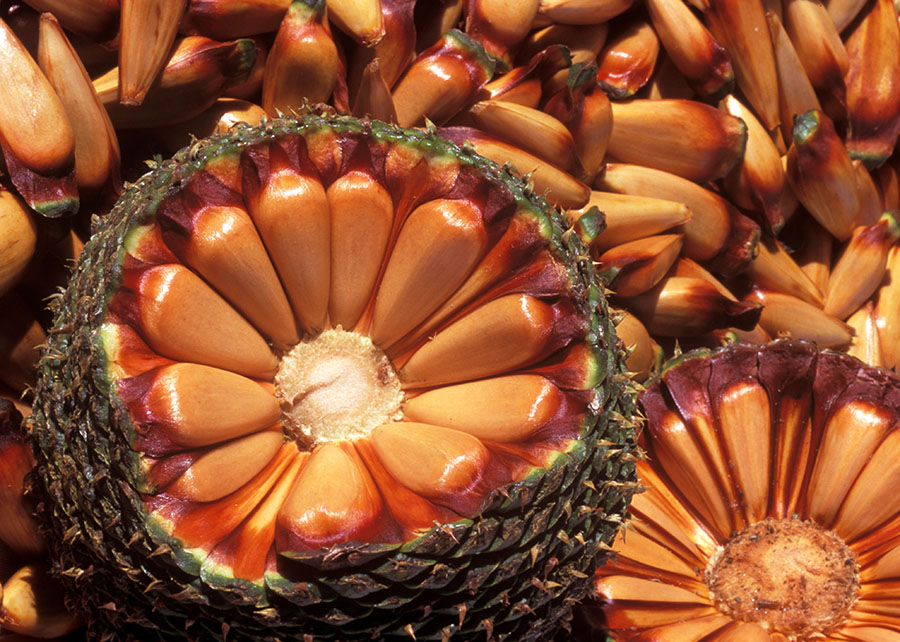
The protocol is the first step to have Brazilian pine nuts be classified and traceable in the market.
Studies conducted by Embrapa Forestry and partners resulted in the first quality and traceability protocol for Brazilian pine nuts – the edible and nutritious seeds of the Paraná pine, Brazilian pine or araucaria (Araucaria angustifolia). The solution paves the way for the creation of the Geographical Indication (GI) seal for the species in Brazil, which would provide consumers with quality assurances. The differentials provided by agricultural research would add increasingly more value to the regional food, which has grown in importance in the domestic market, with potential for growth in the international market.
The new protocol covers the stages from collection to consumption and represents a milestone in the production chain towards higher appreciation of this Brazilian food product that is sourced from forests and is typical of the country's South and Southeast.
In the same line of action to strengthen araucaria as a potentially profitable species to be kept standing from originary forests or planted, generating a sustainable non-timber product, there is a preliminary study on Brazilian pine nut Geographical Indication (GI) seals based on local characteristics and sensory attributes.
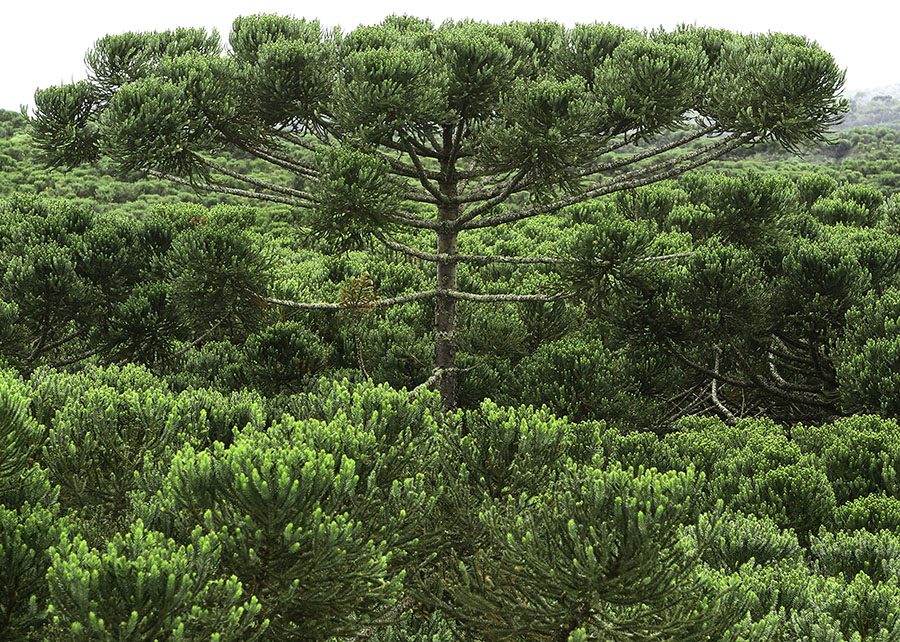
Photo: Luiz Costa
The protocol is the first step to have Brazilian pine nuts be classified and traceable in the market. Two cooperatives in Paraná already plan to adopt the recommendations starting from 2025, by improving gathering, separation, storage and sale of fresh seeds. “It will not be a requirement, but as farmers, technicians and consumers see the positive results of the recommended practices, the adoption of the protocol will tend to occur spontaneously”, explains Rossana Godoy, a researcher at Embrapa Forestry and one of the authors of the document.
As it is a first initiative, the technical team emphasizes that the protocol may be adjusted over time according to stakeholders' demands. “The important thing now is to take the first step”, the researcher stated as she recalled that the standardization of the pine nut supply in the Paraná consumer market should inspire similar initiatives in other producing states, such as Santa Catarina, Rio Grande do Sul, São Paulo and Minas Gerais. According to the most recent official data from the Brazilian Institute of Geography and Statistics (IBGE), Brazilian pine nut production in 2022 was valued at nearly R$52 million reais (R$51.798 million) with a total of 13,376 tons. As the market becomes more organized, production and consumption tend to be consolidated and expand.
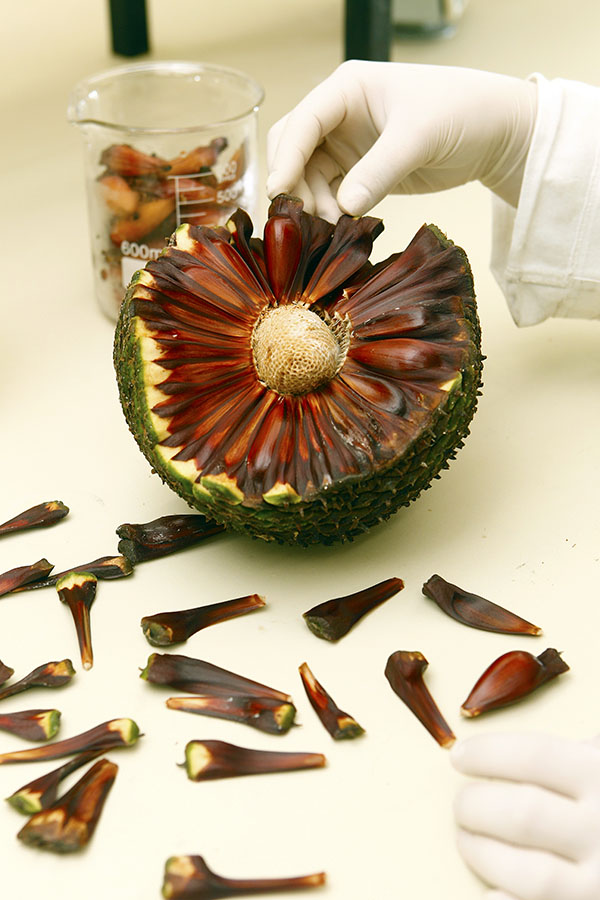 For a path with more technical quality For a path with more technical quality
The protocol offers technical guidelines for all the agents involved in the production and trade of Brazilian pine nuts, as it informs the prerequisites so that the path the seed takes to points of sale is made with quality. The gathering, transportation, processing, packaging and storage of Brazilian pine nuts are detailed in the protocol, which also includes recommendations for labeling and batch identification based on state regulations. Moreover, the document stresses the importance of product traceability, allowing consumers to know the nuts' origin and harvest date, a reassurance of their freshness and quality. The protocol was technically supported by studies researcher Rossana Godoy conducted at Embrapa Forestry. One of them originated the paper “Consumidor de pinhão: hábitos, atributos de importância e percepção” [Brazilian pine nut consumers: habits, attributes of importance and perception], published by the Brazilian journal of forestry research Pesquisa Florestal Brasileira in 2018. Another resulted in the study with pine nut consumers, entitled “Estudo exploratório para identificação e separação de pinhões (Araucaria angustifolia) destinados ao consumo” [Exploratory study for identification and separation of Brazilian pine nuts (Araucaria angustifolia)] intended for consumption, published in the journal Revista Agrária Acadêmica in 2022. There is also the publication “Alterações na composição físico-química de pinhões (Araucaria angustifolia) armazenados em diferentes embalagens e ambientes” [Changes in the physical-chemical composition of pine nuts (Araucaria angustifolia) stored in different packaging and environments], published by Pesquisa Florestal Brasileira in 2023. Photo: Rodolfo Buhrer |
More quality and appreciation of Brazilian pine nuts
Based on these studies, the researcher highlights the need to improve distinctive aspects, with the aim to offer a higher quality product to consumers. “As the Brazilian pine nut is a seed that loses a lot of moisture right after its cone opens, it tends to have a reduced useful life, which requires technical strategies to extend its consumption period. There we identified the urgent need to improve the quality and traceability of the pine nuts sold”, Godoy states.
She also remarks that the the product sold in bulk contains a large mix of pine nuts from different collections. “Nowadays, it is common to find low quality pine nuts mixed with well-sourced ones, which ends up harming product acceptance. There is also a devaluation of a raw material that has the potential to obtain higher added value. With the protocol, we hope to offer a clear and reliable guide for both growers and consumers", the researcher explains.
According to Nivaldo Guimaraes Vasconcellos, an agricultural engineer at the city Secretariat for Food and Nutritional Security (SMSAN) in Curitiba, the protocol is a relevant technical document that will help to structure and develop the Brazilian pine nut production chain. “With this tool, cooperatives and their members will be able to offer a quality product with guaranteed traceability. It is an innovative solution for a product that is a symbol of our region, and we hope that it will leverage the entire production chain and generate income and sustainable development”, he states.
Traceability: where do Brazilian pine nuts come from? Traceability is, in principle, a process that allows the entire journey of a raw material to be traced from its origin to consumption. To track Brazilian pine nuts, after the seeds were selected, the research team applied the Schenkel, in which the pine nuts are covered with water in a 3:1 ratio (three parts of water for one part of Brazilian pine nuts). The test shows that the seeds that float on the water surface had been attacked by borers; the ones in-between were likely to have beem attacked, and the ones that sank to the bottom showed little incidence of borer attacks. In addtion, the Brazilian pine nuts have to be packaged, “generally, in reinforced plastic nets that are closed with a metal seal” and labeled according to rules stipulated by the state (State Resolution 748, Dec 15, 2014) and by the Brazilian Health Regulatory Agency (Resolution RDC 259/2002). The label has to indicate what the product is, batch number, supplier identification, weight, and, in the case of cooperatives, their CNPJ (tax id number), date when the product was received for packaging, and any phytosanitary treatment it may have received. 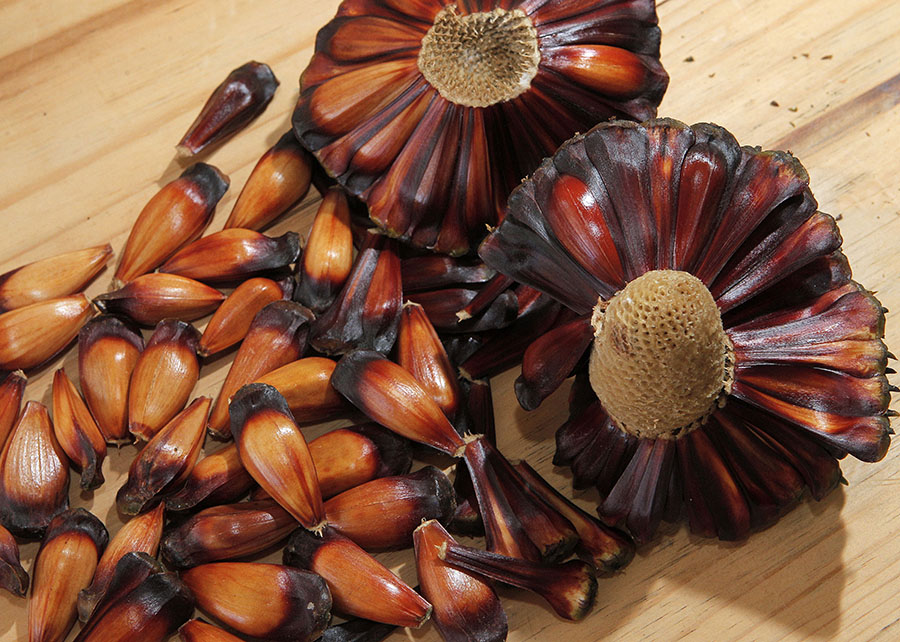
“Traceability is important because determing how long Brazilian pine nut will last hinges on the time of harvest. From the moment the pine cone is opened, the pine nuts start to lose moisture and have an aged appearance. Those Brazilian pine nuts that we buy from the supermarket shelf in bulk have been exposed for a long time and are drying out. They may even be good, but their appearance is lost”, explains Jonas Eduardo Bianchin, extension agent at the Paraná Institute of Rural Development (IDR) and one of the author of the protocol. In addition to learning the origin of the Brazilian pine nut, the farmer will know when it was harvested and thus how long on average it should last with quality. “After they are harvested, healthy Brazilian pine nuts maintain their quality for 10 days in the environment, then they have to be refrigerated, wherein they last another 20 days, after which they have to be frozen”, Godoy explains. Alexandre Marra, supervisor of the Faep/Senar-PR System, highlights the transparency and trust that source-to-table traceability will bring to consumers combined with the availability of a product with higher quality than currently found on the market. “And there are also benefits for society in general, as we are in line with important global goals, such as the United Nations (UN) Sustainable Development Goals (SDGs) focusing on food security, sustainable consumption and production, as well as prospecting public-private partnerships for the development of important production chains, not only here for the metropolitan region of Curitiba, but also for the entire state of Paraná”, he adds. The “new product” complying with the protocol will have higher added value, as it provides higher quality to the seed and consequently will meet the demands of more demanding customers who are concerned about origin and harvest time. “The adoption of practices that focus on offering better quality products naturally promotes impactful changes in the production chain with subsequent consumer loyalty”, the Embrapa researcher observes. Photo by: Luiz Costa |
Pioneers in adopting the protocol
The first cooperative unions (consolidation units) planned to adopt the practices recommended in the protocol are Nascente (Campina Grande do Sul, PR) and Provale (Rio Branco do Sul, PR) which have been following the discussions since the beginning. According to Fernanda Arcie, farmer and member of the Executive Board of Nascente, while many farmers already make some type of selection of the best Brazilian pine nuts either for school meal programs in the municipality of Campina Grande do Sul or for trade, the protocol brings criteria on how to do the process. “We intend to start with the appropriate packaging and labels containing our brand next year’s harvest. This initiative reinforces the great importance of Brazilian pine nuts, as today they are sold in any way, without any criteria and often have flaws. With the new requirements, we believe that we will be able to increase sales, offering better quality products to consumers and generating more income for us, farmers”, she argues.
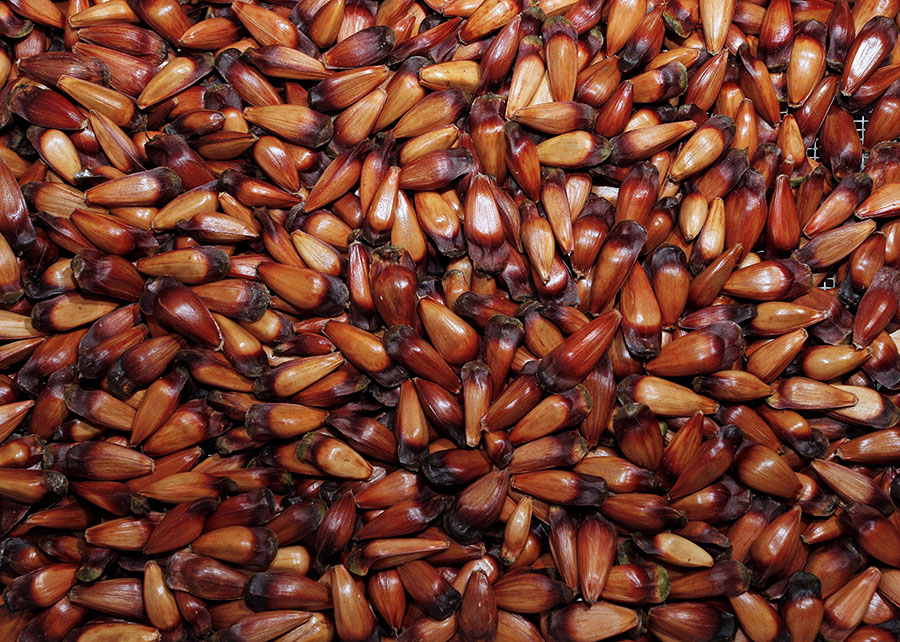
Foto: Luiz Costa
According to Bruno Guimarães, managing partner and chairman of Provale, full compliance with the guidelines should also take place in 2025. “The initiative is very good. We are organizing ourselves so that we can sell it next year. We are currently in talks with growers, with the aim of to guiding processes to comply with the protocol,” he notes.
The document shaped as a leaflet was developed by Embrapa Forestry in collaboration with different partners, including: the Paraná Institute of Rural Development (IDR), Faep/Senar-PR System, Curitiba City Secretariat of Food and Nutritional (SMSAN) and educational institutions such as the Federal Institute of Paraná - Colombo Campus.
Seeking a Geographical Indication (GI) Traceability is an important step in the process of obtaining a Geographical Indication (GI). Characterizing a product and its environment, alongside a sensory analysis, inform the request for seal by the National Institute of Intellectual Property (Inpi). “This study tells farmers how to obtain and what benefits the Geographical Indication seal brings, a process that depends on the environmental characterization of the region and of the product, Brazilian pine nuts in this case. The geographical indication seal and traceability create a regional identity, adding value to the product and benefiting farmers and consumers”, says Elenice Fritzsons, a researcher at Embrapa Forestry and author of the publication. The locations assessed in the study were Lagoa Vermelha, Rio Grande do Sul; Painel, Santa Catarina; Inácio Martins, Parana; and Cunha, São Paulo. In those towns where the Brazilian pine nuts used for analysis came from, there are already rural communities that are either organized or are in the process of becoming organized, for which the nuts are and alternative and complementary source of income. In fact, Painel already has three products with a Geographical Indication seal. |
Manuela Bergamim (MTb 1.951/ES)
Embrapa Forestry
Press inquiries
florestas.imprensa@embrapa.br
Phone number: +55 41 3675-5638 (phone and WhatsApp)
Izabel Drulla Brandão (MTb 1084/PR)
Embrapa Eastern Amazon
Press inquiries
amazonia-oriental.imprensa@embrapa.br
Translation: Mariana Medeiros (13044/DF)
Embrapa's Superintendency of Communications
Further information on the topic
Citizen Attention Service (SAC)
www.embrapa.br/contact-us/sac/





